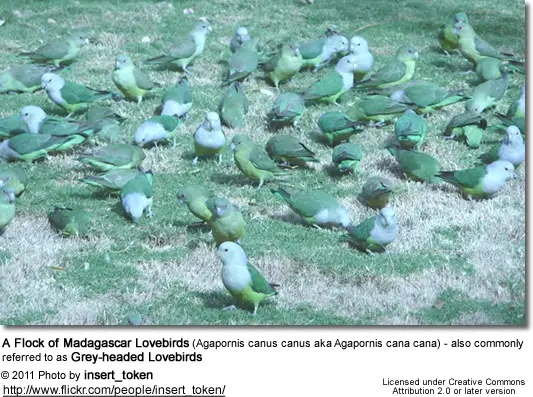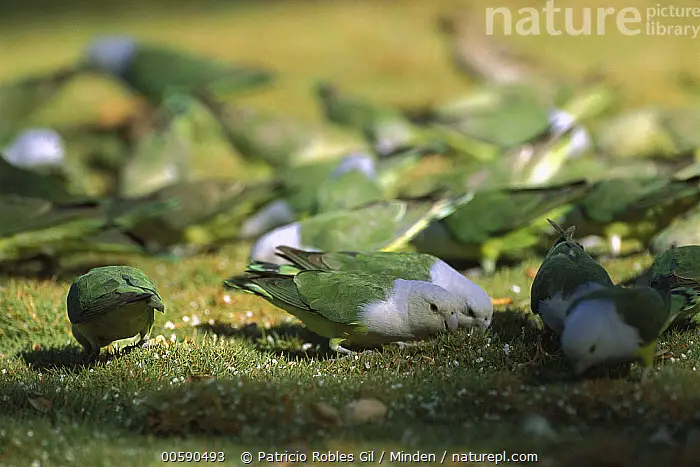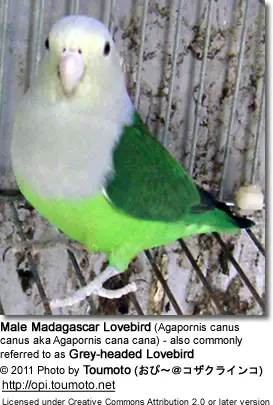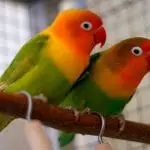Scientific Facts
| Common Name | Grey-headed / Madagascar Lovebird |
| Scientific Name | Agapornis canus |
| Size | 13 centimeters |
| Life Span | 10 – 20 years |
| Habitat | Forest edges and clearings, wooded (e.g., Medemia palm) savanna, scrub, and degraded forest. |
| Country of Origin | Madagascar |
Possibly since its modest pigmentation can’t contend with the bright feathers of the more famous lovebird species, the Grey-headed Lovebird is a somewhat unique bird in confinement. A few specialists suggest them solely to skilled handlers amenable to operate to protect the species in aviculture. Nevertheless, with higher males being produced than females, other handlers notify an irregularity of the reproductions. That implies you may, from time-to-time, discover a male being given for purchase as a pet.
Two subspecies are considerably troublesome to determine individually. Where they are regularly detected in little flights rummaging in trees, both subspecies are endemic to the archipelago of Madagascar.
Physical Description

Being 5 inches tall and scaling nearly 1 – 1.2 lbs, the Grey-headed Lovebird is one of the smallest species of the lovebird genus. Its bill and feet are light shades. The species is reproductively dimorphic: with deep green wings and back, the mature female is uniquely green, a paler green breast, and a brilliant green bottom; besides that, their entire crest and upper ribs are light shades, the grown-up male is comparably painted.
Both possess yellowish signings beneath their underside wings and tails; black inscribing emphasizes the tail feathers and wings.
Male: His wings and back are deep green, while his chest and head are either whitish or pale grey. He also has a black impressing on the tail.
Female: Absence of the gray spot on her temples. With deep green wings and back, she is completely green. She has a vivid green rump and a lighter green chest.
Juveniles: They seem like grown-ups, aside from the male’s shade cranium is tinged with green. The bill is yellowish with black at the bottom.
Flight: Madagascar Lovebirds are skilled flyers that can produce high rates rather swiftly.
Geographical Range
They are endemic to the land of Madagascar, situated on the shoreline of Africa. Short estimates of them may likewise be located on the adjacent sanctuaries. Secluded discoveries have been recorded on the continent of South Africa.
In the wilderness, they commonly transpire in huge flights, though, confined community reproducing has not been frequently victorious. They are generally reproduced in couples.
Appending to it the shipping limitations from their domestic land as well as the difficulties correlated with reproducing this species – Madagascar Lovebirds are not productive growers – this species has grown extremely limited outside their native area.
Habitat
- Forest edges – The transformation region from a space of forest to patches or other public ranges. These edge impacts imply that several species of beings favor forest edges to the center of the woods since they have both security and illumination.
- Wooded savannah – It is a diverse forest-grassland environment portrayed by the trees being adequately broadly aligned so that the covering does not narrow. The clear covering enables adequate brightness to strike the land to sustain an uninterrupted herbaceous cover, including essential grasses.
- Degraded forest – a degraded forest presents a diminished stock of assets and assistance from the assigned place and sustains solely restricted natural variety.
In their natural habitat, these birds relish berries, however most feast on tiny grains from lawns. They blend with flight brothers that can comprise of more than 10. These flights enable them to oversee an emergency at the same time searching on the territory. Madagascar Lovebirds are very bouncy and modest birds. They cannot handle pressure and require their isolation to work in confinement. This lovebird is assumed to behave more similar to a finch instead of a parrot.
Common Behavior
A couple of lovebirds must, at no event, be dwelled with some other species. The Grey-headed Lovebird still professes a danger to less competitive birds settled in their flocks despite more petite and possibly more sensitive than more familiar lovebird species. Obey the practice of one lovebird couple on a flock.

Except if you have a hand-cared kid, you must reasonably assume these birds to stay slightly uncontrollable. Your purpose is to enable them to become associated with you so that they stay relaxed when you tour the aviary. Don’t anticipate them to grow joint birds or pouch pets.
Observe the female firmly. Lovebirds are unique parakeets that create an attempt to bless their dens. You may notice her insert such objects as sowing greens beneath her feathers to take them back to the birdhouse.
Calls And Songs
The Grey-headed Lovebird produces clanging “plee…plee…plee” in aviation and the evening perch. It expresses various signals and screams, and a restrained babbling. If terrified, it presents a range of high-pitched tones.
Diet and Feeding Habits

They are more adapted to tiny grains like seed capsules of chickweed, the tiny seeding grass heads of Poa annua, canary, white millet, Japanese millet, and panicum.
Madagascar Lovebirds have small bills and favor canary and finch seed over the sunflower blends that other lovebirds enjoy. But still, some sunflower administered must be as tiny as that which is supplied to British Finches. A healthy grain mix, along with some egg food and wild seed mix, is a great mixture.
They enjoy apple and green food; a vitamin-mineral addition can be spattered on the latter. Milk and small wholemeal bread can be given, particularly when there are juvenile in the den.
Fresh chop grass is willingly taken. Grit and cuttlebone must be offered accessible. These birds will appreciate regular showers, although they appear to sip surprisingly little water, make certain fresh, clear water is constantly presented in a shoal container.
Reproduction of This Species
The mating period transpires between November and April in Comoros, and between November-December and March in Madagascar.
The Grey-headed Lovebird retreats in wood hollows, normally in stagnant trees such as Acacia, Tamarindus, and different species. The hole is filled with bits of grass finely chewed, bark, and leaf. The den substances are taken by the female within her body shafts.
She offers 3-6 white eggs at one-day periods. She nurses singly throughout 20-23 days (in confinement), commencing with the second egg. The juvenile matures in roughly 44 days, though they are self-sufficient merely following two weeks.
Breeding
Reproducing these birds is demonstrating to be complicated. They do not flourish as healthy in confinement as other lovebirds. A most demand huge cage modifies with utmost secrecy when reproducing this species. Just monitoring on Madagascar’s den can create them to neglect their eggs. Reproducing this bird can be critical. Several handlers are seeking together to further maintain their community within the United States because there is such an inadequate quantity. Shipping this lovebird is not an alternative since conveying extrinsic birds terminated in 1993.
Lovebirds can begin reproducing when they are as juvenile as ten months of duration and may remain continuously; they are five to six years. They are extremely productive and may provide numerous egg clasps inside a single year. As a result, they are commonly immediately accessible on the pet business.
During the mating period, the action among couples will switch: the male shows more disruptive action; at the same time, the female starts making the den. There are particular dwelling crates for lovebird-measurement birds; if not prepared, a quarrion dwelling crates will perform just subtle.
The dens are virtually solely built by the girls. A grasp commonly includes 3 to 6 eggs that are nurtured for approximately 23days. The juveniles will be heeded for by the girl until they abandon the den at nearly 6 weeks of duration. The father later carries over the ingesting of the juvenile birds for an extra two weeks or then until they are detached.
Madagascar Lovebird As Pets
It’s extremely doubtful that the common bird lover will ever get across a ‘favorite’ Madagascar Lovebird for a pet. If they appear, it is assumed these birds do horrible favorites. They are extremely agitated and loathe being touched—even if hand-cared. It is innocent of stating that not sufficient season has been spent to confirm this account. If reproducing this bird remains to be victorious, then one time, more energy could be moved into investigating their pet capability.
Pet Care
It is not an impracticable provocation to hold a grey-headed lovebird in confinement, notwithstanding several merchants do not purchase with them. For instance, if you desire to own this bird for reproducing, you need to understand that the central answer is on the menu. During the periods when they are not in desirous, they must be served with concentrated grains, such as millets and finches, as great as some berry. Except during the mating period, you need to support it with a blend of little egg paste, sprouted seeds, and finches.
Cage
What must the enclosure seem like? A standard enclosure, 23 inches long and 20 or 25 inches high, would satisfy. It is suggested that the platform of the enclosure be treated with gravel, so that it is more comfortable to wash and that the diameter of the enclosure poles does not surpass one centimeter. Furthermore, bear in mind that lovebirds don’t approve an elliptical or house-cast enclosure very serious, so mark for a quadrilateral or rectangular enclosure. There’s no requirement to supply his enclosure with numerous trinkets.
Maintenance
Have their perches and confederates tidy and in great shape. Fundamental enclosure responsibility involves regular washing of the liquid and meat plates. Hebdomadal, you must rinse and sanitize the enclosure. Cleanse and thoroughly wipe the poles and trinkets whenever they become stained. In the aviary, gravel platforms must be replenished yearly.
Handling/Training
Lovebird training is best achieved with a juvenile bird. To own a gentle lovebird, it is likewise most agreeable to act with a single bird. Juvenile birds possess an astonishing capability to master skills and be tender. Grown-ups, contrastingly, are particularly challenging to calm and commonly won’t absorb various know-how or imitate actions. Hand-raised juveniles are most comfortable to manage with. They are already considerably mingled and trained, but regrettably, they are not constantly accessible.
Taming requires approval and faith between you and the bird. It implies consuming plenty of chance with the bird regularly. Begin with speaking gently and making gradual changes. Once the bird is pleased with you, then you can start hand-handling. Apply a rod and drive it smoothly toward the bird’s breast while giving a feast to persuade it up toward the rod. This may need several attempts. Once it is satisfied with moving up onto a rod, exchange your pointer for the rod.
Lovebirds are not recognized as one of the most qualified speakers, and barely some may get several terms.
Availability
The most accessible examples of lovebirds for trade are Fischer’s Lovebirds, the Masked Lovebird, and the Peach-faced Lovebird. There are several pretty lovebird modifications produced from those three flocks of birds that are likewise easily obtainable. Countless other species of lovebird are convenient; however, not mean as quickly discovered. Lovebirds are additionally somewhat economical small parakeets.
It is considerably limited in confinement, with merely a pretty rare handlers having fortunately bred more than one or two periods. When imports were allowed, and they were accessible to aviculture in massive amounts, little application was placed into reproducing.
Attempt to seek for a former partner resembling to discard their bird. Frequently, this is an excellent idea to take a bird and the entire pieces of equipment at once, at a portion of the value.
Protection / status:
The Grey-headed Lovebird is popular and prevalent on entire Madagascar, except it is now isolated on the High Plateau. The species transpires in numerous sheltered regions. It is recognized to forage yields and may harm meadows. Regional business is obvious.
The community is assumed to be steady, and the species is presently assessed as Least Concern.
Justification of Red List category
This lovebird has a surprisingly extensive scope and therefore does not address the outsets for Vulnerable following the array size standard.
FAQs
How do you look after a lovebird?
It is necessary for the well-being of your lovebird; it is crucial to retain coops and trinkets tidy and in excellent .
Do lovebirds need to be in pairs?
Lovebirds do not demand to be in couples. They are friendly birds managed to exist in huge flights. As great as a sole lovebird receives lots of consideration from its human partners, there is no requirement for a spouse.
Where do lovebirds live?
Africa besides for The Grey-headed Lovebird which is endemic to Madagascar
How much do lovebirds cost?
The value of a lovebird will vary on the geographical location, inclusions, breeder, rarity, colors, age, and quality. On normal, intend on consuming wherever from $50 to as substantial as $250 for a bird.
Do lovebirds talk?
Lovebirds Commonly Don’t Speak. Albeit, they are a sort of parakeet, and they do possess the skill to imitate human language. Lovebirds are not with those species that most would contemplate speaking birds



